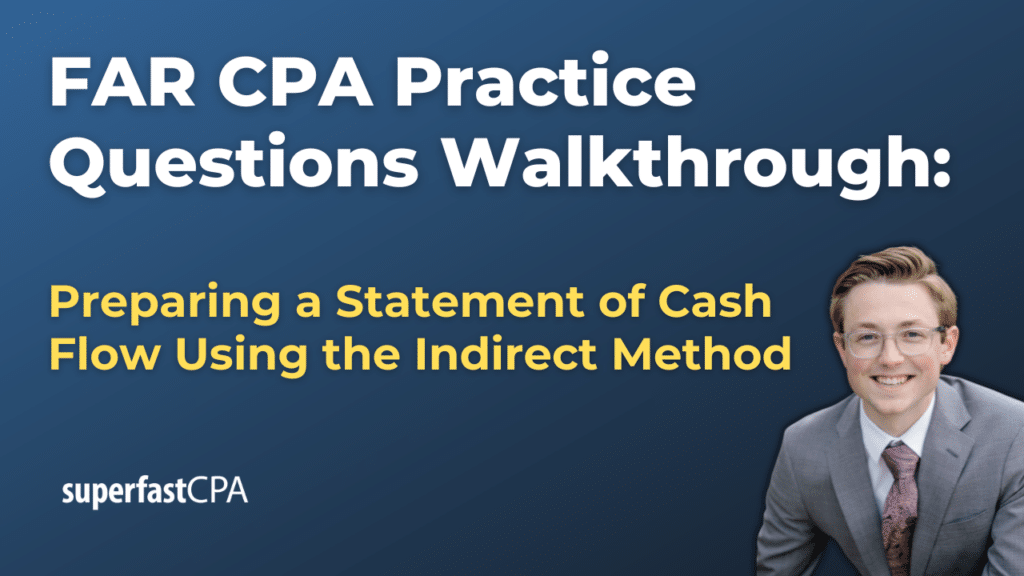In this video, we walk through 9 FAR practice questions teaching about preparing a statement of cash flow using the indirect method. These questions are from FAR content area 1 on the AICPA CPA exam blueprints: Financial Reporting.
The best way to use this video is to pause each time we get to a new question in the video, and then make your own attempt at the question before watching us go through it.
Also be sure to watch one of our free webinars on the 6 “key ingredients” to an extremely effective & efficient CPA study process here…
Preparing a Statement of Cash Flow
The statement of cash flows provides a summary of a company’s cash inflows and outflows during a specific period. It is divided into three sections: operating activities, investing activities, and financing activities. The indirect method adjusts net income for changes in balance sheet accounts to calculate cash flows from operating activities.
Calculating Operating Cash Flow
The operating activities section adjusts net income, derived from the income statement, to reflect actual cash flows from operations. Here’s how to calculate it using the indirect method:
- Start with Net Income
- Adjust for Non-Cash Expenses:
- Add back Depreciation and Amortization: These are non-cash expenses that reduce net income but do not impact cash.
- Add back Impairment Losses: Similar to depreciation, these reduce net income without affecting cash flow.
- Adjust for Non-Operating Gains and Losses:
- Subtract Gains on Sale of Assets: Gains increase net income but do not provide operating cash flow.
- Add Losses on Sale of Assets: Losses decrease net income but do not reduce operating cash flow.
- Adjust for Changes in Working Capital:
- Accounts Receivable: Subtract increases (indicating sales on credit) and add decreases (indicating cash collection).
- Inventory: Subtract increases (indicating cash used to purchase inventory) and add decreases (indicating sales).
- Accounts Payable: Add increases (indicating expenses incurred but not paid) and subtract decreases (indicating cash paid).
- Other Current Liabilities and Assets: Adjust similarly to reflect cash transactions not recorded in net income.
Calculating Investing Cash Flow
Investing activities involve changes in long-term assets, such as property, plant, equipment, and investments. Here’s how to calculate cash flow from investing activities:
- Identify Cash Inflows:
- Proceeds from Sale of Assets: Cash received from selling property, equipment, or investments.
- Proceeds from Sale of Marketable Securities: Cash received from liquidating investments.
- Identify Cash Outflows:
- Purchases of Property, Plant, and Equipment: Cash spent on acquiring long-term assets.
- Purchases of Investments: Cash used to buy securities or financial instruments.
Calculating Financing Cash Flow
Financing activities include transactions that affect the company’s capital structure, involving equity and long-term liabilities. Here’s how to calculate it:
- Identify Cash Inflows:
- Issuance of Stock: Cash received from issuing common or preferred stock.
- Issuance of Debt: Cash received from issuing bonds or obtaining loans.
- Identify Cash Outflows:
- Repayment of Debt Principal: Cash used to repay the principal amount of loans or bonds.
- Dividends Paid: Cash distributed to shareholders as dividends.
- Repurchase of Stock: Cash spent on buying back the company’s own shares.
Required Disclosures
The statement of cash flows includes specific disclosures to provide additional context about cash activities:
- Supplemental Disclosures:
- Cash Paid for Interest and Income Taxes: Companies must disclose total cash amounts paid for interest and income taxes, providing insight into cash outflows not fully captured in the main cash flow sections (because they were already recorded in net income).
- Non-Cash Investing and Financing Activities:
- These activities do not involve cash transactions but affect the financial position, such as converting debt to equity or acquiring assets through leasing. Companies must disclose these separately, often in a note to the financial statements.
Final Presentation
Once each section is calculated, they are combined to present the overall change in cash and cash equivalents for the period. This total should reconcile with the change in the cash balance on the balance sheet from the beginning to the end of the period:
Net Increase (Decrease) in Cash = Operating Cash Flow + Investing Cash Flow + Financing Cash Flow
This provides a complete picture of how cash was generated and used throughout the period, helping stakeholders understand the company’s liquidity and financial health.














